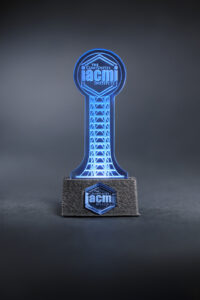It is impossible to separate the history of Oak Ridge, Tennessee from the history of rapid advances in manufacturing. Located in the Knoxville metropolitan area, the town is synonymous with Oak Ridge National Laboratory (ORNL), for good reason: both the town and the renowned research institute were specifically founded to support the activities of the Manhattan Project, the U.S. government program responsible for the creation of the atomic bomb.
This narrative is so enmeshed into the town’s existence that Oak Ridge High School (ORHS), for instance, was itself founded for the children of workers involved in the Manhattan Project. Against this background, then, it is perhaps not surprising that ORHS is the focal point for what has to be one of the most interesting electives in the U.S. public school system, Wildcat Manufacturing.
Naturally named after the school’s mascot, Wildcat Manufacturing is run by Dr. Mark Buckner, who wasn’t even a teacher until 2021. Prior to that, he’d spent 32 years at ORNL. After he retired, ORHS fortuitously landed Buckner as the head of the high school’s new advanced manufacturing program, which emerged thanks to $1.24 million from Tennessee’s Innovation School (iSchool) Grant initiative.

But Wildcat Manufacturing is not just a school club. It operates as a fully functioning service bureau business, powered by an array of smart manufacturing technologies, including over a dozen 3D printers, a water jet cutter, and a 5-axis CNC machine. In addition to its association with Oak Ridge’s reputation as an innovation hub, Wildcat Manufacturing has also benefitted from a relationship with the nearby Manufacturing USA organization, the Institute for Advanced Composites Manufacturing Innovation (IACMI).
Specifically, the connection between Wildcat Manufacturing and IACMI is America’s Cutting Edge (ACE). ACE, a partnership of ORNL, the University of Tennessee, and IACMI, is a national initiative dedicated to educating individuals of all ages — including middle and high school students — in advanced machining technologies. Many of the participants in Wildcat Manufacturing were first introduced to 3D printing and other smart manufacturing technologies via ACE, which is one of the reasons why the company was on the radar of Margaret Slattery, IACMI’s marketing and communications manager.
Building the Sunsphere
- Image courtesy of Wikipedia.
“Because a lot of these kids had already gone through our training and I was looking for a local artist, I thought, why don’t we just hire them to make exactly what we want?” Margaret said. “Since I work from home a lot and I was trying to figure this all out, Devin overheard me, and before I knew it, he had gone into Fusion 360 and had created a mockup of IACMI’s logo inside the Sunsphere.” She continued, “I was like, ‘We should totally do this!’ So much swag is not made here — the bulk of it is made in China — so that was another important thing for IACMI, to have something that was truly U.S. designed and manufactured.”
Fittingly, the Sunsphere’s base is made from composites: “We wanted to make sure it was made out of carbon fiber,” Margaret noted. “The carbon fiber filament is from one of our members, Vartega. Being the Composites Institute, it was important to us that it be a different material than say, PLA.”
Workforce Development
The Sunsphere project also highlights another major IACMI priority, workforce development. Given that there has been such a major push lately by U.S. policymakers to encourage high school graduates to consider manufacturing job training as an alternative to college, the Sunsphere order seems to have been timed especially perfectly.
“I think our goal [at Wildcat] is to get kids ready for whatever career path is right for them. That could be college, going to trade school, or into the workforce right out of high school,” Devin said. “Some kids may just not be right for college, so Wildcat Manufacturing gets them ready for going into a machining shop.”
Margaret added, “I think the goal is to take that stigma away from those that don’t choose college, and to really introduce the idea that there are multiple paths to success. Sometimes this means not only talking with the kids about this, but letting the parents know that there are other good options for kids out there.” She elaborated, “There is a huge shortage of talent going into these manufacturing jobs. We’re looking at the number of skilled laborers that are retiring in the next ten years, and the ramping up of manufacturing in the U.S., and there’s just not going to be enough people to fill the jobs. That’s why we’re making a concerted effort now to not get to the point where we don’t have [that labor pool].”

Running a Real Business
Although Wildcat Manufacturing is operated by high school students, many of its employees do seem to see the company as the first step in entire future careers in manufacturing. Devin said that one of the things he values most about participating in the business is the experience of the real world that is largely unavailable in a typical public-school curriculum.
When I asked what, in particular, is most unique about what he learns by helping to participate in a business, his response was unhesitating: “I think it’s the problem-solving skills. If we have issues with a printer, issues with a laser cutter, we have to fix that because we have a deadline in a week. We have to get this stuff done!”
Thus, Wildcat Manufacturing does not expect special treatment just because it’s run by teenagers. In fact, if anything, Devin seems to be eager for more honesty than many customers may be willing to give:
“Let’s just take the base of the keychain as an example. At first, since it’s very tiny — about an inch in width — we tried embossing the IACMI logo in there and it didn’t really work out, so we had to pivot. And luckily, since it’s my mom giving the feedback, we got honest feedback — ‘This doesn’t look good. That doesn’t look good.’ But then some clients…we were making a trophy, for instance, and they did not give honest feedback, we could tell.”
Margaret added, “They didn’t want to hurt [the teenagers’] feelings. I’m gonna tell ‘em exactly what I want, what I need, what’s working, what’s not working.”
Devin nodded in agreement, “It’s what I need! I want to be getting real world experience.”
Finally, possibly the most impressive thing about the company is its financial profile. The program is set up to be self-sustaining, meaning that the revenues from sales go back into ORHS. This is not only good for the education budget, but also means that students aren’t being set up to have their favorite activity abruptly axed from the activities catalog. Additionally, I was particularly struck by Wildcat Manufacturing’s remuneration system:
“I do want to point out,” Margaret explained, “that the model that they’ve set up for this business is profit sharing. It’s not necessarily that you get X dollars per hour. As a group, they look at how many hours each person spends, how much was brought in, and they have to run all the numbers. Before I was willing to do this, I said, ‘I need to know what you’re going to charge me.’ So, it’s in their best interest to make sure that they are efficient, they are watching the materials, and they’re making sure that they get things done in a timely manner.”
If only the rest of the economy could operate this smoothly! Excitingly, Wildcat Manufacturing might very well play a role in something like such a reality eventually coming to pass: the program is already using its technology resources as a way to reach other schools in rural Tennessee, and I could easily see it expanding on a federal level.
That could have implications not only for the U.S. education system at large, but truly for any organization looking to add a self-sustaining, smart manufacturing service bureau to its operations. Wildcat Manufacturing may not pack the same immediate wallop as the atomic bomb, though that doesn’t mean it won’t do its own part to help change the course of American manufacturing.
Thanks to Hannah Whitson and Margaret & Devin Slattery for making the interview possible. Unless otherwise noted, images courtesy of IACMI
Subscribe to Our Email Newsletter
Stay up-to-date on all the latest news from the 3D printing industry and receive information and offers from third party vendors.
Print Services
Upload your 3D Models and get them printed quickly and efficiently.
You May Also Like
3D Printing News Briefs, December 3, 2025: Vapor Smoothing, Microneedles, & More
Happy 3D Printing Day! In today’s 3D Printing News Briefs, we cover everything from a 3D printer order and vapor smoothing to microneedles, surgical training models, and more. Read on...
Indian Additive Construction Firm MiCoB Delivers Over 500 Bunkers to the Indian Army
Like many nations attempting to capture Industry 4.0 gains, India laid out an ambitious long-term plan in 2014 to transform its economy: the Make in India initiative. However, as is...
Boston’s Additive Edge at Autodesk: Harvard Researchers Turn Mining Waste into Masonry
When most people look at piles of mining waste, they see rubble. For Maddie Farrer and Chenming He, two researchers at Harvard’s Graduate School of Design (GSD), those rocks look...
3D Printing News Briefs, November 12, 2025: Standards, Printhead, UV Printing, & More
We’re starting with standards news from ASTM International in today’s 3D Printing News Briefs, and then moving on to business, as Precision Plastics Australia launched a new collaborative venture. ValCUN...


































